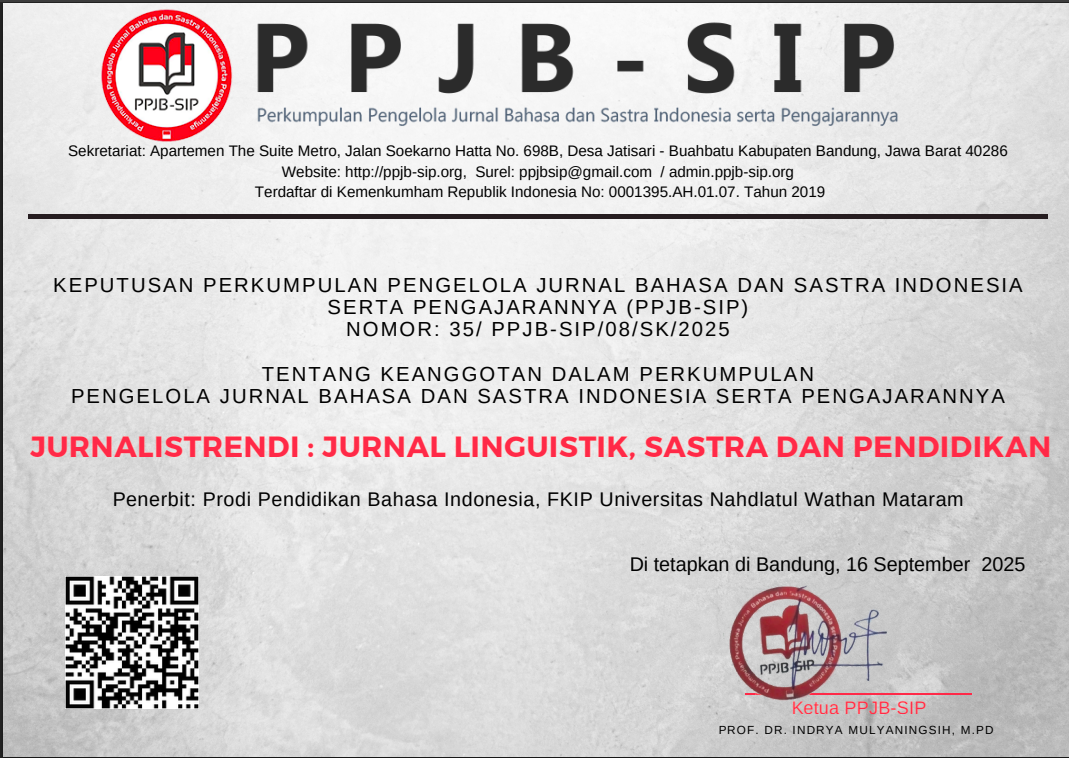Verb Formation of Derivational Sasak Prefix: Morphological Study
Abstract
This study aims to explore the morphological process of verb formation through derivational prefixes in the Sasak language, focusing on the Meno-Mene dialect spoken in Kuripan village, Lombok Island. The research has two primary objectives: first, to identify the kinds of prefixes in Sasak that can form verb categories in terms of derivation, and second, to determine the types of base morphemes that can be combined with each prefix to form verbs. This study use descriptive qualitative method. The result of this study identifies 4 (four) prefixes, including /be-/ (consist of /be-/ and /ber-/ as allomorph), /m-/, /peN-/ (consist of /pe-/ and /per-/ as allomorph), and /N-/ (consist of /n-/, /ng-/, and /ny-/ as allomorph). The findings indicate that these prefixes attach to specific categories of base morphemes to produce verbs. For instance, the prefix /be-/ can combine with nouns, adjectives, and adverbs, while /peN-/ has a broader range, attaching to noun, adjective, adverb, and number of word category. The prefix /m-/ is limited to noun category, and /N-/ is exclusively affixed to noun category. This study provides valuable insights into the derivational morphology of the Sasak language, contributing to the understanding of verb formation processes in Austronesian languages. The findings highlight the systematic nature of prefixation and its role in expanding the verb lexicon within the Sasak language.
Downloads
References
Simaremare, D., Silalahi, D.E., & Purba, L. (2021). Derivational Affixes In Writing Analytical Exposition Text, JOLLT Journal of Languages and Language Teaching, 9(1), 44-52. DOI: https://doi.org/10.33394/jollt.v%vi%i.2999
Herman. (2015). Suffixes Found in Narrative Writing at Grade Eight of SMP Methodist Pematangsiantar. Journal of Humanities and Social Science.
Fasold, R. W. and Linton, J. C. (2014). An Introduction Language and Linguistics. United Kingdom: Cambridge University Press.
Syarifaturrahman, Wahyu K., et al. "The Inflection of Sasak Language in Kuripan Village: A Morphological Study." International Journal of Social Sciences and Humanities, vol. 1, no. 3, 31 Dec. 2017, pp. 155-181, doi:10.29332/ijssh.v1n3.69.
Syarifaturrahman, W. K. ., sutarman, & Abdussamad, Z. . (2021). A Morpho-phonemic Analysis on Sasak Affixation . International Journal of Linguistics, Literature and Translation, 4(1), 122–130. https://doi.org/10.32996/ijllt.2021.4.1.13
Suastini, N. W., & Apriliani, K. (2018). Indonesian prefix ter. Journal of Applied Studies in Language, 2(2), 192-196.
Syarifaturrahman, W. K., Abdussamad, Z., & Rahmawati, L. (2022). Morphological study of affixation in Sasak Selaparang dialect. Humanitatis: Journal of Language and Literature, 8(2), 297-306. https:// doi.org/10.30812/humanitatis.v8i2.2022
Setiyadi, D. B. P., Haryono, P., & Herawati, N. (2022). Morphophonemics of the Morpheme {N} in the Javanese language. Eurasian Journal of Applied Linguistics, 8(3), 70-82.
Sari, N. W. E. M., Sulatra, I. K., & Putra, I. W. N. (2020). The use of derivational affixes in colours magazine by Garuda Indonesia. Journal of Language and Applied Linguistics, 1(2), 184-194. https://doi.org/10.22334/traverse.v1i2
McKinley, J., & Rose, H. (2020). The Routledge handbook of research methods in applied linguistics. Taylor and Francis
Maylawati, D. S. A., & Saptawati, G. P. (2017). Set of frequent word item sets as feature representation for text with Indonesian slang. Journal of Physics: Conference Series, 801(1), 012066. https://doi.org/ 10.1088/1742-6596/801/1/012066
Martin, A., & Culbertson, J. (2020). Revisiting the suffixing preference: Nativelanguage affixation patterns influence perception of sequences. Psychological Science, 31(9), 1107-1116. https:// doi.org/10.1177/0956797620931108
Kalee, S., Rasyid, Y., & Muliastuti, L. (2018). åError analysis on the use of affixation in Indonesian paper written by a Thai student. Lingua Cultura, 12(3), 289-293. https://doi.org/10.21512/lc.v12i3.4307
ntiana, S. R. H., & Sapiin, S. (2014). The affix Me-/-kan and Me (n)-/-kan in the presidential candidates’ debate texts in 2014–2019: Morphology observation on derivation and inflection. International Journal of Linguistics, Literature and Culture, 3(2), 66-77.
Hutaminingrum, M. P. D. (2022). An analysis of affixation processes of derivation and inflection in article with the title “The Government of the Republic of Indonesia”. Linguistics Initiative, 2(1), 70-76. https://doi.org/10.53696/2775371 9.2132
Kalin, L. (2022). Infixes really are (underlyingly) prefixes/suffixes: Evidence from allomorphy on the fine timing of infixation. Language, 98(4), 641-682.
Genon-Sieras, S. V. (2020). Affixations and allomorphs in verbs and nouns in a research abstract: A morphemic and morphophonemic analysis. International Journal of English Language Studies, 2(2), 14-22.
Creemers, A., Don, J., & Fenger, P. (2018). Some affixes are roots, others are heads. Natural Language & Linguistic Theory, 36(1), 45-84. https://doi.org/10.1007/ s11049-017-9372-1
Anis, M. Y., & Saddhono, K. (2016). The antonym of lexeme using the affixation’ me-kan’: Morphosemantics analysis. Journal of Language and Literature Education, 16(1), 1-13. https://doi.org/ 10.17509/bs_jpbsp.v16i1.3057
Syahid, Agus, et al. Fenomena Anglisisme: Gabungan Prefiks Informal Nge-Bahasa Indonesia dan Kelas Kata Bahasa Inggris. Humanitatis:Journal of Language and Literature,vol.10, no.1, Dec. 2023. Pp. 1-12,doi: https://doi.org/10.30812/humanitatis.v10i1.3489
Sukri, M. (2015). [M<-> N] Sebagai Afiks Derivasional Dan Infleksional Dalam Bahasa Sasak Dialek Kuto-Kute. RETORIKA: Jurnal Ilmu Bahasa, 1(1), 123-136.
Sutarman, S. (2017). Derivational and Inflectional Affixation in Menu-Meni Dialect of Sasak Language. Humanitatis: Journal of Language and Literature, 4(1), 121-136
Copyright (c) 2024 Jurnalistrendi : Jurnal Linguistik, Sastra dan Pendidikan

This work is licensed under a Creative Commons Attribution-NonCommercial 4.0 International License.

.jpg)





